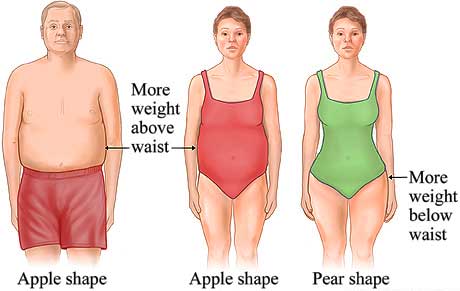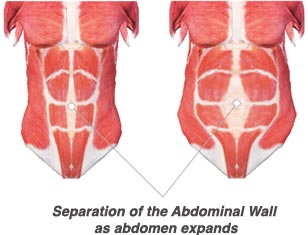1. Genetics
Where you gain fat and how easy it is to lose belly fat is partly down to genetics. Our genes help determine how many fat cells we have and where these fat cells are stored.1
Most men preferentially deposit fat in their abdominal area, this is due to the action of male hormone testosterone. The stress hormone, cortisol also encourages belly fat.
Women tend to deposit fat on the hips, thighs and buttocks, which is down to the effects of the female hormone, estrogen.2 For this reason, a woman’s body shape changes and belly fat increases after the menopause when estrogen levels decrease.
Though men tend to have more belly fat than women, men generally lose belly fat faster as a result of regular exercise.
Read more: The Best Exercises to Lose Belly Fat
2. Body Shape
Your body shape also affects how easily you lose belly fat:
- Pear-shaped: smaller upper body than lower body. People with this shape tend to have a flat, tummy, but find it harder to lose body fat is from the lower body. The easiest place to lose weight is from the upper body.
- Apple-shape: bigger upper body than lower body. People with this body shape tend to carry more weight in trunk and arms. This means that losing belly fat is harder. Also, people with an apple shape are more likely to have higher levels of deep belly fat (visceral fat), which can negative effects on health. For this reason, losing belly fat is particularly important.
Read more: How to Lose Belly Fat

3. Body Fat
A higher body fat percentage means that there will be more body fat generally, including the hips and legs, as well as the tummy area.
To lose body fat follow a healthy, balanced diet and incorporate regular exercise. A healthy diet that will help with losing belly fat, while regular cardio will help burn fat and strength training will tone your body and abs.
Read more: The Best Diet to Lose Belly Fat
4. Stress
The stress hormone known as cortisol, promotes fat to be deposited in the belly area. High levels of cortisol are linked with greater amounts of belly fat.3 Alcohol, smoking, caffeine, and stress all increase cortisol levels.
5. Post-Pregnancy
Post pregnancy the uterus is heavier than pre-pregnancy causing the uterus to drop. The uterus does return to its pre-pregnancy size, but takes about 6 weeks to do so.
Also, it is common during pregnancy for the right and left sides of the rectus abdominis, aka the “six-pack” muscles, to spread apart down the middle (called the linea alba). This is known as diastasis recti abdominis, or divarication. Up to 60% of women are though to experience diastasis recti during after pregnancy.4

Therefore, avoid ab exercises such as crunches until that process is complete, as they will force these muscles farther apart.
Don’t rush into exercising, give yourself at least 2 – 3 months before doing vigorous or high-impact exercise.
Always speak to your doctor or midwife before starting an exercise program, particularly if you’ve had a caesarean section. It is essential to ensure your abdominal muscles have healed before starting vigorous exercises.
Pelvic floor exercises can help to re-train and strengthen your pelvic floor muscles and your deepest tummy muscle layer (transversus abdominus). The pelvic floor muscles help to stabilize the pelvis and support the organs of the lower abdominal cavity, including the bladder and uterus.
Pelvic floor strengthening exercises known as Kegels (named after Dr. Kegel) generally recommended for strengthening the pelvic floor. The transversus abdominus is a deep abdominal muscle and acts as a corset, pulling you in. Exercises targeting the transversus abdominus will help to strength your core and flatten your belly, by pulling it in from the inside out.
6. Bloating
You know you have a bloated belly, if it starts off relatively flat in the morning, but grows larger throughout the day with gas or indigestion.
Bloating can affect you irrespective of size, you may be slim or overweight. Your belly may be bloated due to food intolerances, sluggish bowels as a result of a poor diet or a relatively unknown, but probably common condition called Small intestinal bacterial overgrowth (SIBO).
SIBO is when there are abnormally high levels of bacteria in the small intestine, especially the type of bacteria usually found in the colon (large intestine) than the small intestine. Basically, there are two problems (1) too much bacteria and (2) the wrong type of bacteria in the wrong place.
The symptoms of SIBO include excess gas, abdominal bloating and distension, diarrhea (less frequently constipation) and abdominal pain. It is thought that many people labelled with Irritable Bowel Syndrome (IBS), are in fact suffering with SIBO.
Read more: 14 Effective ways to stop bloating
Factors that increase likelihood of belly fat
There are several factors that increase the likelihood of developing excess deep belly fat, including:
• Male gender
• Post-menopausal women
• Obesity
• Sedentary lifestyle
• Smoking
• Heavy drinking (3 or more drinks per day for men, 2 or more drinks for women)
• Chronically high stress levels
• Poor diet, particularly if high total fat, saturated fat and refined carbohydrates.


I have that problem about waking up in the morning with a relatively flat stomach that grows bigger throughout the day 🙁
Well I do have lots of fat there since I’m constantly stressed and don’t eat very well.
The combo is just horrible 🙁